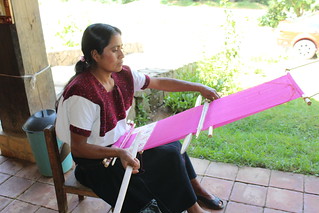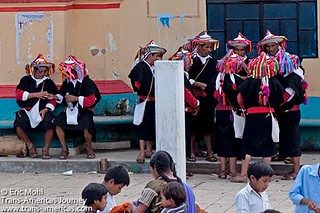Most travelers that visit Chamula go from there directly to the nearby village of San Lorenzo Zinacantán. We would be visiting Zinacantán later in the day but as long as we were this close, we also wanted  to take the opportunity to head a bit further north to visit the weavers in the Tzotzil-speaking village of San Andrés Larráinzar. Like Tenejapa, San Andrés does not attract a large number of tourists but for lovers of fine textiles, it is well worth a visit.
to take the opportunity to head a bit further north to visit the weavers in the Tzotzil-speaking village of San Andrés Larráinzar. Like Tenejapa, San Andrés does not attract a large number of tourists but for lovers of fine textiles, it is well worth a visit.
If your only memory of hearing about the State of Chiapas is of the uprising against the Mexican government in the 1990s by local indigenous people who formed a resistance movement known as the Zapatistas; San Andrés Larráinzar was at the center of the conflict and in fact was the site of peace negotiations ending the open hostilities. While the movement still exists in some more remote areas, the current Mexican government is attempting to follow through on many of the promises made in the 1996 settlement and there is now in general, a peaceful co-existence.
But the attraction San Andrés held for us is its reputation of having one of the oldest and finest weaving traditions in of all of Mexico. Typically San Andrés weavers work with cotton or wool thread colored with natural dyes and use designs that are based on patterns originating in lowland Chiapas during the Classic Maya Period (300-900 A.D.) Much of the best of what you’ll see in the Sna Jolobil and other weaving co-operative showrooms in San Cristóbal is created by San Andrés weavers.
 Our first stop in San Andrés was at Grupo Luchetih, a local weaving co-operative. We met weavers Rosa Diaz Diaz (shown in our photos) and Victoria Diaz Lopez. The piece that Rosa Diaz Diaz is working on in these photos is a version of “the toad” pattern, which symbolizes fertility of Earth. If you click on either photo, it will take you to a larger version for closer inspection.
Our first stop in San Andrés was at Grupo Luchetih, a local weaving co-operative. We met weavers Rosa Diaz Diaz (shown in our photos) and Victoria Diaz Lopez. The piece that Rosa Diaz Diaz is working on in these photos is a version of “the toad” pattern, which symbolizes fertility of Earth. If you click on either photo, it will take you to a larger version for closer inspection.
Unlike the raw heavy feel of the weaving and dress in Chamula, the textiles and style of dress in San Andrés Larráinzar show a refinement in texture, design and color that has stood the test of time and in fact holds a strong appeal to modern tastes.
From the Grupo Luchetih weaving co-operative, we headed to the square in the center of the town as Sunday is also market day in San Andrés Larráinzar. This is another village where the local citizens are very sensitive to having their picture taken; particularly around the church so unfortunately, we don’t have any pictures to show of the amazing scene we witnessed.
their picture taken; particularly around the church so unfortunately, we don’t have any pictures to show of the amazing scene we witnessed.
However, in doing research for our trip, we came across trans-americas.com, a website by an author who was not so reluctant to take photos of the church and church officials as we were so we’ve included two of those photos as representative of some of what we saw.
The square was packed tight with people in front of the church and visiting market vendors that stretched down the street. While there was a service going on inside of the church, outside in front of the entrance was a small string band, which included a harp and two guitars and a line of 8-10 Maya religious officials, dressed similarly as shown in the picture below.
The market started to the left of the church and only a few yards from the doorway was a vendor selling peeled fresh fruit and another deep frying whole river fish. As we contemplated a late-morning snack, the string musicians began to play and the religious officials began a dance that was more of skip from the church door back and forth towards the center of the square.
 While they were still dancing, we paid a small admittance fee and entered into another world inside of the church.
While they were still dancing, we paid a small admittance fee and entered into another world inside of the church.
The air was heavy with the smoke and smell of incense and the room was packed with worshipers. There were green pine needles spread across the floor and candles burning on all of the side table alters as well as in formations on the floor mixed in among the standing crowd. A service was being conducted in the Tzotzil Maya language and the leaders of the service shared the front of the church with a mariachi band.
We stayed near the back of the room and positioned ourselves along a wall so that we wouldn’t disturb the worshipers who spent a good deal of the service singing and dancing along to the band’s music and quite obviously feeling the spirit. We felt so privileged to have witnessed such an event.
After we had taken about all the smoke we could handle we exited the church and did a quick walk-through the market. It was mostly more of the same of we had seen in Chamula but we did take time to buy a couple round fat chicken tamales (for about 50 cents total) that the vendor pulled from a steaming pot.
Before departing the area, we made one last attempt at getting a photo and asked permission from a group of young men dressed in traditional attire sitting on a bench near the entrance to the church. With a shrug of the shoulders, they said no gracias.
We made our way back to the car and were off to our next stop for the day: San Lorenzo Zinacantán.
